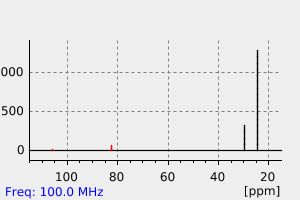2,2,4,4,5,5-Hexamethyl-1,3-dioxolan | 17226-67-4
中文名称
——
中文别名
——
英文名称
2,2,4,4,5,5-Hexamethyl-1,3-dioxolan
英文别名
2,2,4,4,5,5-Hexamethyl-1,3-dioxolane
CAS
17226-67-4
化学式
C9H18O2
mdl
——
分子量
158.241
InChiKey
WMZFIRPHBANWEP-UHFFFAOYSA-N
BEILSTEIN
——
EINECS
——
-
物化性质
-
计算性质
-
ADMET
-
安全信息
-
SDS
-
制备方法与用途
-
上下游信息
-
文献信息
-
表征谱图
-
同类化合物
-
相关功能分类
-
相关结构分类
计算性质
-
辛醇/水分配系数(LogP):1.7
-
重原子数:11
-
可旋转键数:0
-
环数:1.0
-
sp3杂化的碳原子比例:1.0
-
拓扑面积:18.5
-
氢给体数:0
-
氢受体数:2
反应信息
-
作为反应物:描述:2,2,4,4,5,5-Hexamethyl-1,3-dioxolan 、 以 四氢呋喃 为溶剂, 以13.2 mg的产率得到(4aR,6R,7R,7aS)-2,2-ditert-butyl-6-phenyl-7-(4,4,5,5-tetramethyl-1,3,2-dioxaborolan-2-yl)-4a,6,7,7a-tetrahydro-4H-thieno[3,2-d][1,3,2]dioxasiline参考文献:名称:An Access to the β-Anomer of 4′-Thio-C-ribonucleosides: Hydroboration of 1-C-Aryl- or 1-C-Heteroaryl-4-thiofuranoid Glycals and Its Regiochemical Outcome摘要:We have developed a novel method for the synthesis of the beta-anomer of 4'-thio-C-ribonucleosides from 3,5-O-(di-tert-butylsilylene)-4-thiofuranoid glycal. Palladium-catalyzed coupling of 1-tributylstannyl-4-thiofuranoid glycal with iodobenzene or a heteroaryl halide gave 1-C-phenyl- or 1-C-heteroaryl-glycals. Hydroboration of these glycals proceeded at the alpha-face, and subsequent alkaline hydrogen peroxide treatment of the resulting 2'-alpha-borane furnished the respective beta-anomer of 4'-thio-C-ribonucleosides. These results demonstrate that this synthetic method has a wider scope in terms of heterocyclic base structure. During this study, unexpected Markovnikov-oriented hydroboration has been observed to lead to the respective 1'-alpha-boranes. These 1'-boranes were converted into either the ring-opened structure or the 2'-deoxy derivatives depending upon their stability.DOI:10.1021/jo201100n
-
作为产物:描述:参考文献:名称:基于全甲基化环醚的稳定锂氧电池电解质摘要:基于醚的电解质由于其相对较高的稳定性而常用于Li-O 2电池(LOB)。但是它们仍然易于通过氢提取反应受到超氧化物或单线态氧的攻击,这导致长期运行期间性能下降。本文中,我们提出了甲基化的环状醚2,2,4,4,5,5-六甲基-1,3-二氧戊环(HMD),作为LOB的稳定电解质溶剂。这样的化合物在醚的α-碳上不包含任何氢原子,从而避免了氢的夺取反应。结果,该溶剂在超氧化物或单线态氧的存在下表现出优异的稳定性。另外CO 2禁止在充电过程中进化。使用基于HMD的电解质的LOB可以运行157个循环,是基于1,3-二氧戊环(DOL)或1,2-二甲氧基乙烷(DME)的电解质的LOB的4倍。DOI:10.1002/anie.201812983
文献信息
-
METHOD FOR PRODUCING AROMATIC COMPOUND申请人:Sumitomo Chemical Company, Limited公开号:US20150322101A1公开(公告)日:2015-11-12A method is provided for producing an aromatic compound, including a step of mixing a compound represented by formula (A) and a compound represented by formula (B): in the presence of at least one phosphine compound selected from the group consisting of a phosphine represented by formula (C) and a phosphonium salt represented by formula (F): a base, a palladium compound, and an aprotic organic solvent.
-
PROCESSES FOR PRODUCING A FLUOROSULFONYL GROUP-CONTAINING COMPOUND AND A COMPOUND LED FROM THE FLUOROSULFONYL GROUP-CONTAINING COMPOUND申请人:OKAZOE Takashi公开号:US20080287694A1公开(公告)日:2008-11-20A fluorosulfonyl group-containing compound having a high polymerization reactivity, a process for its production, a sulfonyl group-containing polymerizable monomer led from the sulfonyl group-containing compound, and a polymer obtainable by polymerizing the sulfonyl group-containing polymerizable monomer, are provided. A compound (3) is fluorinated to form a compound (4), and then, the compound (4) is subjected to a decomposition reaction to produce a compound (5). A preferred compound (5-1) of the compound (5) is thermally decomposed to produce a compound (7-1) having a high polymerization reactivity. wherein R A is a bivalent organic group such as a fluoroalkylene group, R AF is a group having R A fluorinated, or the same group as R A , each of R B to R D which are independent of one another, is a hydrogen atom, etc., each of R BF to R DF is a fluorine atom, etc., R E is a monovalent organic group, R EF is a group having R E fluorinated, or the same group as R E , E is a bivalent connecting group, E F is the same group as E, or a group having E fluorinated, E F1 is a group formed by scission of E F , each of X 1 to X 3 is a hydrogen atom, etc., and each of X 1F to X 3F is a fluorine atom, etc.提供了一种含有氟磺酰基团的高聚合反应性化合物、其制备方法、由含有磺酰基团的聚合单体引导的磺酰基团含量的聚合物以及通过聚合磺酰基团含量的聚合单体获得的聚合物。化合物(3)被氟化形成化合物(4),然后,化合物(4)经历分解反应产生化合物(5)。化合物(5)的优选化合物(5-1)被热分解产生具有高聚合反应性的化合物(7-1)。 其中,RA是双价有机基团,例如氟烷基团,RAF是RA氟化的基团,或者与RA相同的基团,RB到RD中的每一个都是独立的,是氢原子等,RBF到RDF中的每一个都是氟原子等,RE是单价有机基团,REF是RE氟化的基团,或者与RE相同的基团,E是双价连接基团,EF是与E相同的基团,或者是E氟化的基团,EF1是通过EF断裂形成的基团,X1到X3中的每一个都是氢原子等,X1F到X3F中的每一个都是氟原子等。
-
Aminopropenoates as Fungicides申请人:DUBOST Christophe公开号:US20110152322A1公开(公告)日:2011-06-23The present invention relates to aminopropenoate derivatives, the process of their preparation, intermediate compounds, their use as fungicide active agents, particularly in the form of fungicide compositions, and methods for the control of phytopathogenic fungi, notably of plants and in material protection, using these compounds or compositions.
-
Cyanoenamines and Their use as Fungicides申请人:Benting Jürgen公开号:US20130298291A1公开(公告)日:2013-11-07The present invention relates to cyanoenamine derivatives, their process of preparation, intermediate compounds, their use as fungicide active agents, particularly in the form of fungicide compositions, and methods for the control of phytopathogenic fungi, notably of plants and in material protection, using these compounds or compositions.
-
Method for producing 2-alkylcarbonylnaphtho[2,3-b]furan-4,9-dione-related substance, and said related substance申请人:Sumitomo Dainippon Pharma Co., Ltd.公开号:US10738023B2公开(公告)日:2020-08-11Provided is a method for producing a 2-alkylcarbonylnaphtho[2,3-b]furan-4,9-dione-related substance, which is suitable for the production on an industrial scale. The present invention provides: a method for producing an intermediate for the production of a 2-alkylcarbonyl[2,3-b]furan-4,9-dione, which comprises reacting a 1-butyne derivative in which a ketone or an alcohol is protected with a 2-hydroxy-1,4-naphthoquinone derivative having a leaving group at position-3 in a solvent in the presence of a metal or a metal compound and a base; and a substance relating to the intermediate.
表征谱图
-
氢谱1HNMR
-
质谱MS
-
碳谱13CNMR
-
红外IR
-
拉曼Raman
-
峰位数据
-
峰位匹配
-
表征信息
同类化合物
(反式)-4-壬烯醛
(s)-2,3-二羟基丙酸甲酯
([1-(甲氧基甲基)-1H-1,2,4-三唑-5-基](苯基)甲酮)
(Z)-4-辛烯醛
(S)-氨基甲酸酯β-D-O-葡糖醛酸
(S)-3-(((2,2-二氟-1-羟基-7-(甲基磺酰基)-2,3-二氢-1H-茚满-4-基)氧基)-5-氟苄腈
(R)-氨基甲酸酯β-D-O-葡糖醛酸
(5,5-二甲基-2-(哌啶-2-基)环己烷-1,3-二酮)
(2,5-二氟苯基)-4-哌啶基-甲酮
龙胆苦苷
龙胆二糖甲乙酮氰醇(P)
龙胆二糖丙酮氰醇(P)
龙胆三糖
龙涎酮
齐罗硅酮
齐留通beta-D-葡糖苷酸
鼠李糖
黑芥子苷单钾盐
黑海棉酸钠盐
黑木金合欢素
黑曲霉三糖
黑介子苷
黄尿酸8-O-葡糖苷
麻西那霉素II
麦迪霉素
麦芽糖脎
麦芽糖基海藻糖
麦芽糖1-磷酸酯
麦芽糖
麦芽四糖醇
麦芽四糖
麦芽十糖
麦芽六糖
麦芽五糖水合物
麦芽五糖
麦芽五糖
麦芽五糖
麦芽三糖醇
麦芽三糖
麦芽三糖
麦芽三塘水合
麦芽七糖水合物
麦芽七糖
麦法朵
麦可酚酸-酰基-Β-D-葡糖苷酸
麦利查咪
麝香酮
鹤草酚
鸢尾酚酮 3-C-beta-D-吡喃葡萄糖苷
鸡矢藤苷







